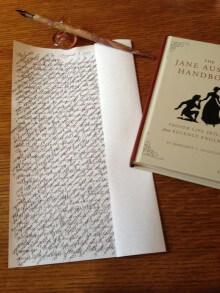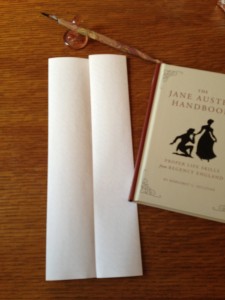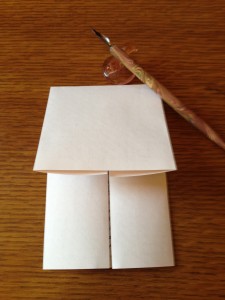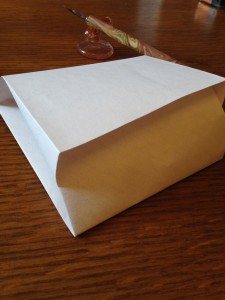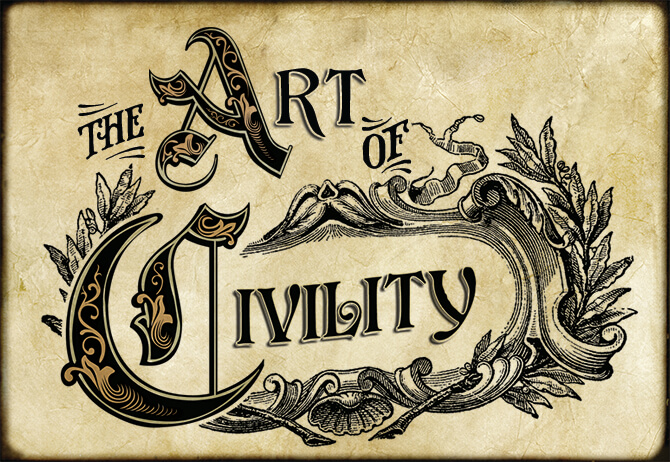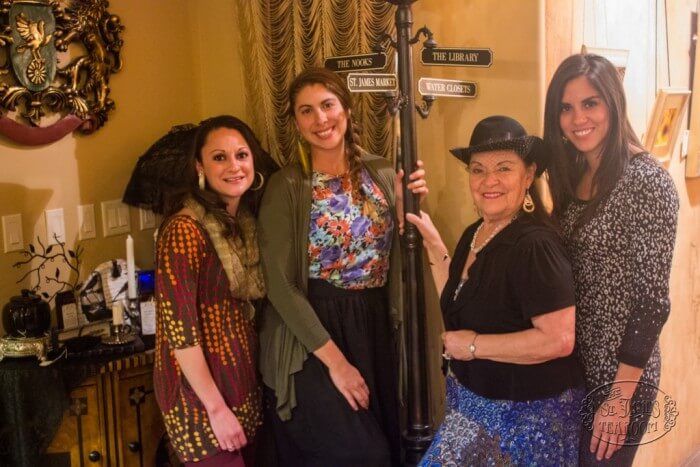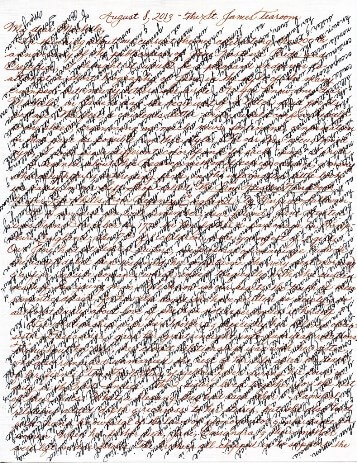
How Jane Austen REALLY wrote letters…
(This photo is a realistic sample of a simple note for Mr. Darcy upon the bicentennial celebration of Pride & Prejudice.)
In Jane Austen’s day, there was no email, and no texting, of course. People communicated in a slower, but much more genteel fashion – the letter. I believe that we are missing that gentility in our own day. In the beginnings of our ’email age’, we thought it was exciting – “You’ve got mail!” Oh boy! Who has written me and what did they say?! Now, however, if you are like me, any “You’ve got mail!” sound makes my stomach hurt. Oh no! Not more mail! Yet, send me a realio-trulio LETTER, snail mail style, and you have my full, undivided attention.
Well. I think it’s high time for the handwritten letter to come back into fashion! As we are celebrating Jane Austen at the tearoom this month – “Tea with Mr. Darcy”, and delighting in the 200th anniversary of Pride & Prejudice, I thought I would explore Jane’s life and the common style of letter writing used during the Regency era. So I wrote a letter to my friend Michele, with a brief biography and some of my thoughts on this woman whose works have been read and loved for 2 centuries, and I wrote it in the Regency fashion of the day (see it above). Can you decipher it? (If not, I include the text of it below.)
In Jane’s day, the recipient of a letter paid the postage. Thus, to save expense, as much news and sentiment was squeezed onto one sheet of paper as was possible. Here is my first ‘page’:
The second ‘page’ was written on top, and at an angle. (You are lucky. Sometimes the writer would finish the first page, then turn it upside down to write the second page in between the lines of the first, and THEN would turn the page at a 45 degree angle for the third page!) Once I wrote the second page on top of the first, I realized I should have written both in black ink, which would have made it more readable.
The actual write-as-I-thought-it-out text of my letter is below, as well as instructions for the folding of this style of correspondence:
August 8 – The St. James Tearoom
My dear Michele,
In thinking about our current theme, celebrating the 200th anniversary of the publication of Jane Austen’s Pride & Prejudice, I thought it would be a pleasant endeavor to attempt a short biography of Jane in the style of the many cramped-but-newsy letters she wrote. As you know, my dear Michele, in Jane’s day, the recipient of a letter paid for its postage. Therefore, a courteous letter writer would confine herself to one sheet, cramming as much news, sentiment, and information on that page as possible, in this style. For our less-accustomed eyes, I will use a different color of ink for each page I write. I learned about this method of correspondence, and many other delightful and interesting facts, in the informative little book we carry in our Gift Shop, called The Jane Austen Handbook – Proper Life Skills from Regency England, by Margaret Sullivan. As I am sure you remember, dear friend, Jane Austen was born December 16, 1775, in her father’s parsonage in Hampshire, England, the 7th of 8 children, and the youngest of 2 girls. Our Jane had at least 2 suitors, one proposal of marriage, (which she accepted, but then rescinded this acceptance the very next morning), and a fine seaside romance which ended sadly with the sudden death of the young man. We know in our hearts the truth of these romantic details, for how else could she have written so deeply and so authoritatively about love if she had not experienced it herself? Her relationship with her brothers and especially her beloved older sister, Cassandra, gave her great insight into familial relations. Throughout her life, her closest relationship was with her sister, who also remained unmarried, after the tragic death of her fiancé, Tom Fowle, who died of yellow fever during his tour of duty in the West Indies. The 2 sisters lived together for the rest of their lives. What a blessing they had each other! Familial relations added depth and richness to her stories, but she also had first-hand knowledge of the laws of primogeniture and inheritance for women. When her father died, Jane, Cassandra, and their mother were left in dire straits. The brothers all chipped in to support the three women. Brother Francis and his wife opened their home to them, and they lived together for several years until brother Edward inherited a large estate from a rich cousin and offered them a cottage there. I have been to this lovely cottage in Chawton (and had tea across the lawn in a most charming tearoom called ‘Cassandra’s Cup’). It is a happy thing and a delightful picture to imagine Jane there at her little table, penning her timeless novels about life in her times, observing those around her, noticing the actions and reactions of these, looking deeply, seeing well, weaving all this information into stories that reach into the hearts and sensibilities of any who care to read them. Her powers of observation, her ability of perception of motive, and genius of description and story have gifted the world she left behind for 200 years. Times have changed, history has forged ahead, and yet the human heart has not changed, and thus her novels are just as instructive on that subject as the day she wrote them, just as funny, just as satisfying! The struggles of love, the predicaments of life one finds oneself in, betrayals and betrothals, the joys and the trials of family life and community life are universal, timeless. This is surely one of the reasons Jane Austen’s novels have endured. And how very delicious to see our own struggles and perplexities lived out and worked out in the lives of the sensible Elinor and the headstrong romantic Marianne, or the silly Harriet Smith and the haughty Mrs. Elton, or the final meeting of the minds and hearts of a pretty girl – Elizabeth Bennet – and Mr. Darcy! The world has become a richer place for the work of this single woman, Jane Austen, who labored with pen and ink to put down the people, the places, and the predicaments of her times for posterity. (And how is that, my dear friend, for an example of alliteration?!) In Jane’s day, a woman had few options if she had to support herself. She could become a governess, a school teacher, a companion, a lady’s maid, or an authoress, and each occupation was ill-paid and unpleasant in its own way. Jane started writing seriously at age 20, and continued to write until her death at the much-too-young age of 42. All her novels were published anonymously. It wasn’t until late in her life that she began to be known as the author of these popular works. She discussed her stories privately with her sister and confidante, Cassandra, but did not make much of herself as a writer – many of her family were unaware of her authorship for many years. Those who did know, however, were intensely proud of her, revealing her identity as the author as often as they could! Jane died much too early, but in a day of such limited opportunities for women, so many obstacles and difficulties, what Jane Austen achieved is amazing. She gave freely of what she possessed – her powers of observation and discernment, her wit and her ability to turn a phrase, her brilliance at identifying the undying human condition, and genius at wrapping all this into a compelling and intimate saga we can all relate to. She would be astounded at her impact! It is well that we celebrate this anniversary. Now you know why Jane Austen is one of the tearoom’s British Greats!
Fondly yours,
Mary Alice
To get the letter ready for the post, it was folded so:
This was a fun project, and a mental challenge! Would you like to try it yourself?
Send me a Real Letter, written Regency-style, in care of the tearoom, and especially with news about Jane’s triumph, Pride & Prejudice, and I will display it in our Market. We would all love to see your attempt at this style of correspondence, and hear what you have to say about Jane! If you try it, you will discover how much more concentration it takes to write your thoughts down on paper in this manner. There is no going back to substitute another word; if a word is misspelled or you put the wrong punctuation, the only correction you can do is scratch it out. It is a little more difficult to read, without the separations for paragraphs and the ‘white space’ we are so spoiled with, but it is a sweet thing to concentrate on another’s words to oneself, I believe, and good for us.
I found that using a ruler helped me as I tried to read. It would have been easier to read if I had used black ink for both ‘pages’. Also, by using a sturdier paper, the little folded package eliminates an envelope and works quite nicely. Jane, in her day, would seal it with wax, but since our postal service will not allow sealing wax, a sticker would work just as well.
I think if we wrote our communications in this manner, we would probably become better writers, more attuned readers, and possibly better thinkers! But one thing is for certain, those who receive our letters will be thrilled at the personal time and attention we took. The effect will be something like this:
Yours for Grace, Civility, Beauty, Gentility, & Excellence
(It’s all about Relationship!)
Mary Alice Higbie





